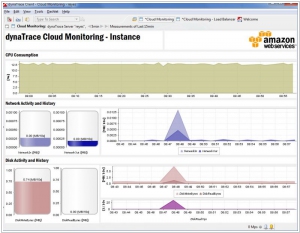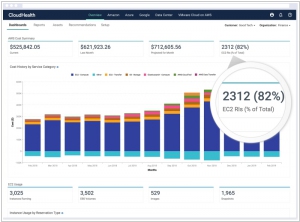Amazon CloudWatch vs CloudHealth
July 29, 2023 | Author: Michael Stromann
See also:
Top 10 Cloud Management platforms
Top 10 Cloud Management platforms
Amazon CloudWatch and CloudHealth are both cloud management and monitoring services provided by Amazon Web Services (AWS), but they have different focuses and functionalities. Here are the key differences between Amazon CloudWatch and CloudHealth:
1. Purpose and Focus:
- Amazon CloudWatch: It is primarily a monitoring and observability service that provides real-time insights into the performance and health of various AWS resources and applications. It helps users monitor metrics, logs, and events to ensure the availability and performance of their infrastructure.
- CloudHealth: It is a cloud management platform that focuses on optimizing cloud costs, governance, and security. CloudHealth provides tools and analytics to help users manage and control their cloud spending, track resource utilization, and enforce compliance policies.
2. Functionality:
- Amazon CloudWatch: It offers a wide range of monitoring capabilities, including collecting and tracking metrics, creating alarms and notifications based on predefined thresholds, and visualizing logs and events. It integrates with many AWS services and can monitor resources like EC2 instances, RDS databases, Lambda functions, and more.
- CloudHealth: Apart from monitoring, CloudHealth focuses on cost management and optimization. It provides cost visibility, budgeting tools, and recommendations to optimize resource usage and identify potential cost savings. It also offers governance and security features, such as policy enforcement, compliance reporting, and vulnerability scanning.
3. Scope of Monitoring:
- Amazon CloudWatch: It is primarily focused on monitoring AWS resources and services. While it can integrate with some third-party applications and on-premises resources, its core functionality revolves around AWS infrastructure.
- CloudHealth: It has broader multi-cloud and hybrid cloud support. In addition to monitoring AWS resources, CloudHealth can also monitor resources in other cloud providers, such as Microsoft Azure and Google Cloud Platform. This makes it useful for organizations with a multi-cloud or hybrid cloud setup.
4. Integration and Ecosystem:
- Amazon CloudWatch: It integrates seamlessly with other AWS services and tools, making it easy to collect and analyze data from various AWS resources. It also provides APIs and SDKs for custom integrations and supports integration with third-party tools.
- CloudHealth: It has a wider ecosystem and provides integration with multiple cloud providers, including AWS, Azure, and Google Cloud. CloudHealth can aggregate data from different cloud platforms, allowing users to have a unified view of their multi-cloud environment.
See also: Top 10 Cloud Management platforms
1. Purpose and Focus:
- Amazon CloudWatch: It is primarily a monitoring and observability service that provides real-time insights into the performance and health of various AWS resources and applications. It helps users monitor metrics, logs, and events to ensure the availability and performance of their infrastructure.
- CloudHealth: It is a cloud management platform that focuses on optimizing cloud costs, governance, and security. CloudHealth provides tools and analytics to help users manage and control their cloud spending, track resource utilization, and enforce compliance policies.
2. Functionality:
- Amazon CloudWatch: It offers a wide range of monitoring capabilities, including collecting and tracking metrics, creating alarms and notifications based on predefined thresholds, and visualizing logs and events. It integrates with many AWS services and can monitor resources like EC2 instances, RDS databases, Lambda functions, and more.
- CloudHealth: Apart from monitoring, CloudHealth focuses on cost management and optimization. It provides cost visibility, budgeting tools, and recommendations to optimize resource usage and identify potential cost savings. It also offers governance and security features, such as policy enforcement, compliance reporting, and vulnerability scanning.
3. Scope of Monitoring:
- Amazon CloudWatch: It is primarily focused on monitoring AWS resources and services. While it can integrate with some third-party applications and on-premises resources, its core functionality revolves around AWS infrastructure.
- CloudHealth: It has broader multi-cloud and hybrid cloud support. In addition to monitoring AWS resources, CloudHealth can also monitor resources in other cloud providers, such as Microsoft Azure and Google Cloud Platform. This makes it useful for organizations with a multi-cloud or hybrid cloud setup.
4. Integration and Ecosystem:
- Amazon CloudWatch: It integrates seamlessly with other AWS services and tools, making it easy to collect and analyze data from various AWS resources. It also provides APIs and SDKs for custom integrations and supports integration with third-party tools.
- CloudHealth: It has a wider ecosystem and provides integration with multiple cloud providers, including AWS, Azure, and Google Cloud. CloudHealth can aggregate data from different cloud platforms, allowing users to have a unified view of their multi-cloud environment.
See also: Top 10 Cloud Management platforms





